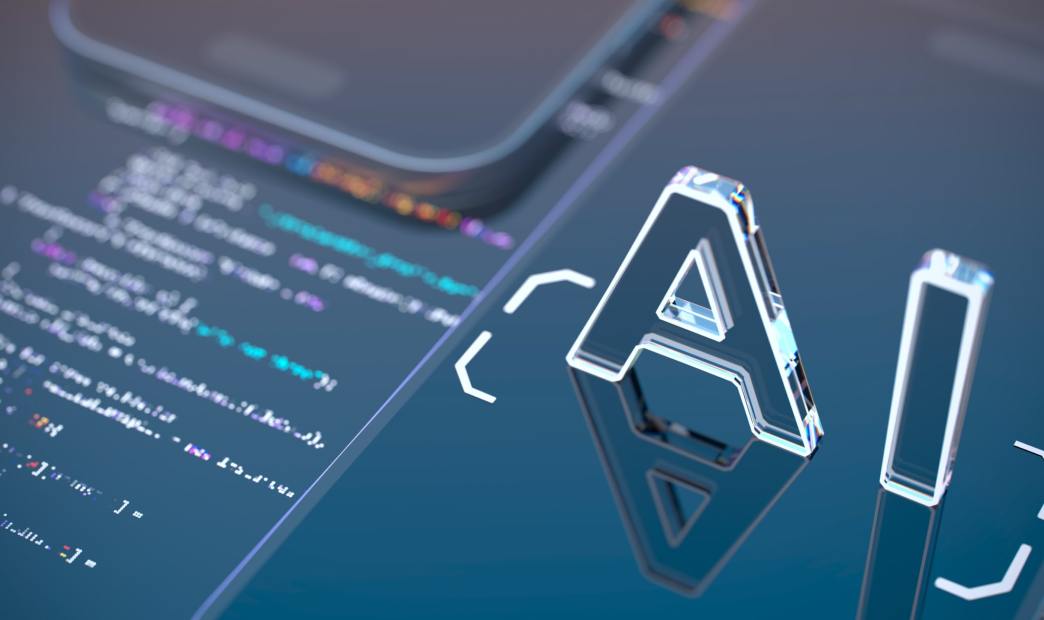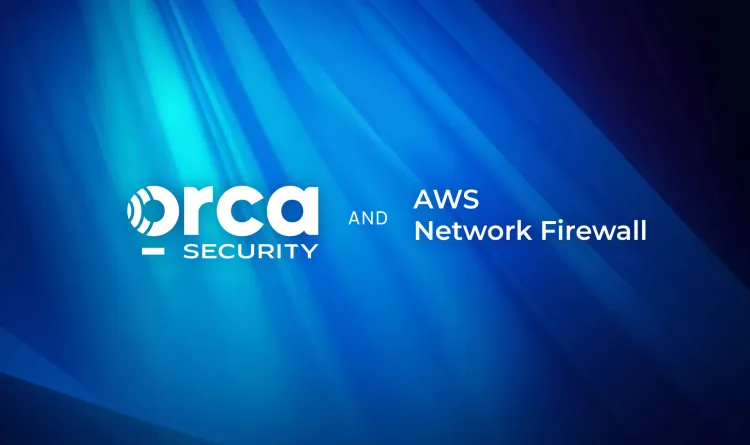In cloud security, speed is of the essence. Organizations need speed to stay ahead of the attackers who are constantly scanning the Internet for vulnerable targets, but also to keep up with DevOps teams who are developing cloud-native applications at a rapid pace. However, with the cybersecurity industry facing a serious skills shortage and the ever-increasing complexity of cloud environments, cloud security teams are struggling to keep up.
In this blog, we discuss the challenges that cloud security teams are facing, and how the integration of generative AI can help organizations reduce their cloud security risk and help address long standing challenges in the industry.
Challenge #1: Cloud Security Skills Shortage
One of the biggest challenges of the cyber security industry is the shortage of skilled workers. According to the ISC2 2023 Cybersecurity Workforce Study, the global cybersecurity workforce had a shortfall of 4 million workers in 2023, which is a 12.6% increase compared to 2022. A recent study conducted by Enterprise Strategy Group (ESG) and Information Systems Security Association (ISSA) shows that 71% of cybersecurity professionals say their organization has been impacted by the cybersecurity skills shortage.
Generative AI is proving to be a powerful tool in helping cloud security teams multiply their productivity by simplifying tasks, lowering skill thresholds, and generating optimal configurations. This alleviates daily workloads and stress while allowing teams to focus on higher-value tasks.
Challenge #2: Increasing Complexity of Cloud Environments
With most organizations rapidly expanding their cloud footprint and choosing a multi-cloud strategy to get the most business benefit from each cloud provider, cloud attack surfaces are not only growing but also becoming more complex.
In our alert fatigue survey, we found that 55% of organizations are using three or more cloud service providers, mostly AWS, Azure, and Google Cloud. However, IBM Cloud, Oracle Cloud and Alibaba Cloud are also in the mix. Although they all offer similar services and capabilities, each platform is unique in its own way. Each offers specialized services, has its own specific configurations and security settings, and uses proprietary naming conventions. Add to this the fact that new cloud-native technologies are constantly being introduced, and even highly skilled cloud security engineers will struggle to keep up.
The more complex the cloud environment, the greater the chance of misconfigurations that can put organizations at risk. This is where generative AI can be a game changer. For instance, by leveraging AI to generate specific remediation instructions and code for a detected risk on a specific cloud platform, cloud security engineers get specialized assistance – reducing the need for expert knowledge of each specific setting on each specific platform.
Another example is when generative AI allows users to ask plain language questions instead of having to use a proprietary query language or create queries. AI-powered search can guess what you are probably looking for, even if you may not be using the exact right wording. For instance, if you ask ‘Which virtual instances are stopped?,’ AI engines can create a query that searches for the appropriate stopped status names for each provider, including ‘deallocated’ and ‘terminated’ statuses. If there are other relevant search parameters, the query can suggest further search refinements.
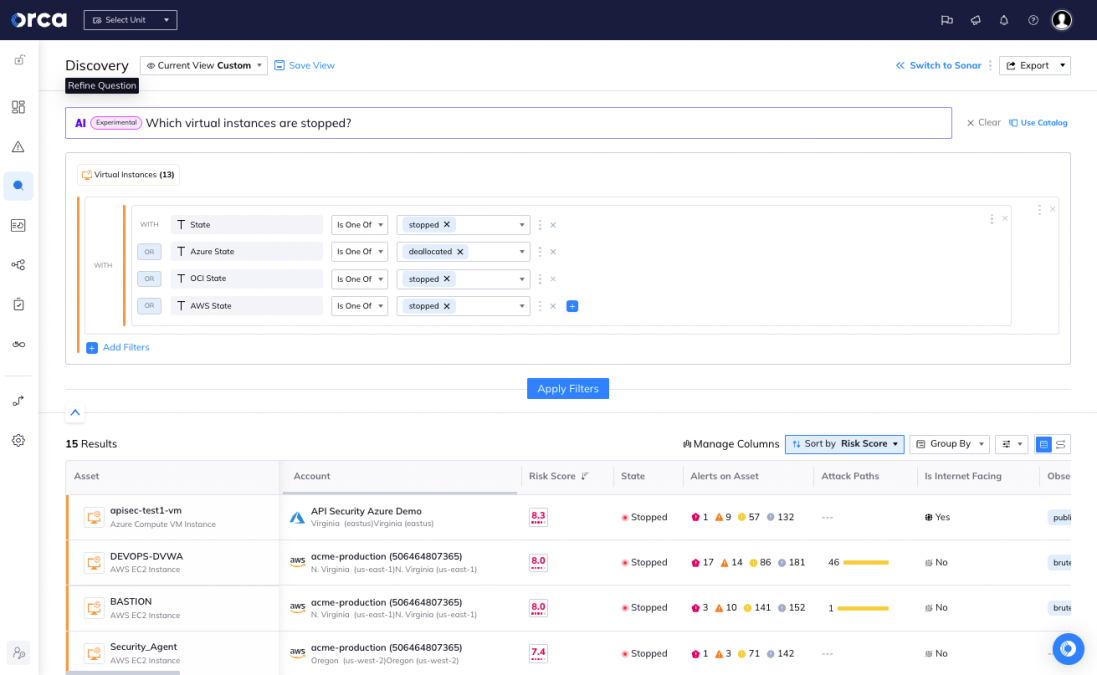
AI-powered search eliminates the need to know all the different naming conventions for each cloud provider
“These new tech tools can help teams reduce complexity and focus on what matters most, which may be why 84% of executives plan to prioritize generative AI cybersecurity solutions over conventional cybersecurity solutions.”
The CEO’s guide to generative AI – Cybersecurity by IBM
Challenge #3: Staying Ahead of Attackers
Unfortunately, generative AI can also be used for nefarious goals. Bad actors are using AI to generate malware and automate attacks. This is making cybercrime possible for less sophisticated attackers who don’t have much coding knowledge and is enhancing their ability to find and exploit vulnerabilities and misconfiguration.
“While we also expect to see AI help attackers, AI should give defenders an advantage because AI is good at amplifying capability based on data — and defenders have more data.”
Phil Venables, VP/CISO, Google Cloud
In zero-day situations where security teams need to respond quickly, generative AI can help security teams quickly understand their exposure and take swift mitigating actions assisted by AI.
For instance if we take the example of Log4Shell, AI-powered search allows organizations to understand which assets are vulnerable within minutes, and perform further granular searches such as ‘Which assets have log4j vulnerabilities, are Internet facing and have access to sensitive data’ so they can swiftly prioritize their efforts and ensure the most critical risks are addressed first.
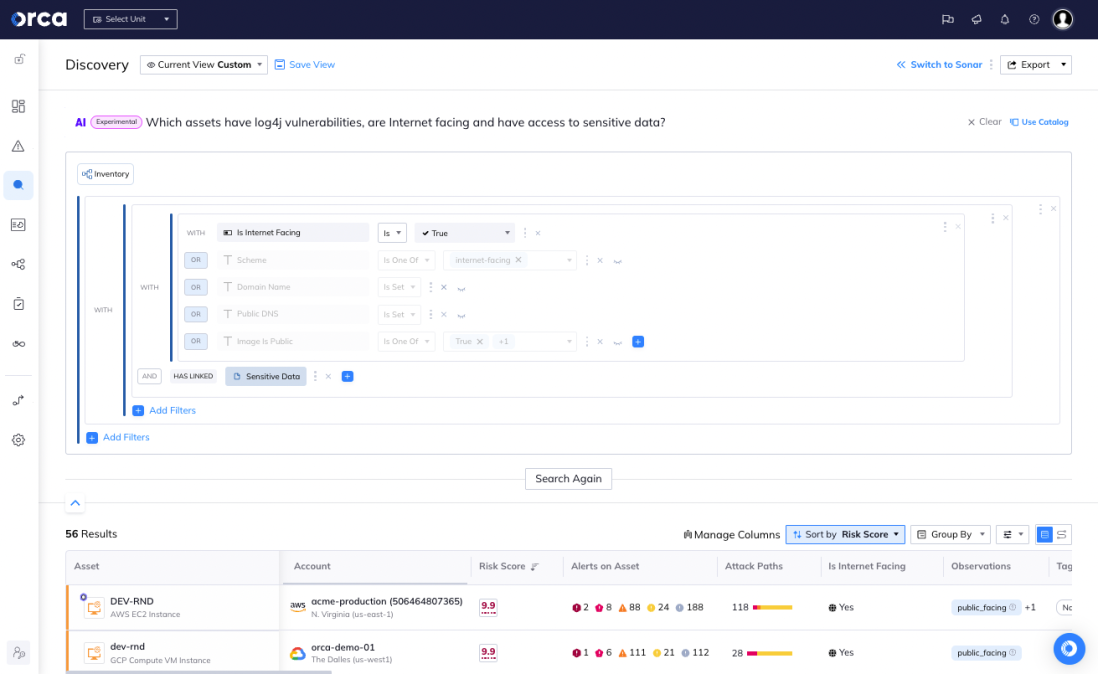
In zero-day situations, AI-powered search enables users to quickly understand their exposure
Challenge #4: Alert Fatigue and Desensitization
Short-staffed cloud security teams receive hundreds of alerts every day that require investigation, remediation, and response – and often have to rely on cloud security tools that are difficult to operationalize and use. Our alert fatigue survey found that the majority of security teams receive upwards of 500 cloud security alerts per day. This is leading to desensitization and burnout, as well as missed critical alerts: 55% of respondents said that critical alerts are being missed, often on a weekly and even daily basis.
Cloud security augmented by generative AI can alleviate the daily burden on security teams by accelerating the investigation and prioritization of alerts, as well as providing suggested remediation steps and code literally within seconds. This allows teams to quickly understand which issues to focus on and take swift action, and avoid critical alerts being missed. In turn, this improves job satisfaction and reduces burnout and turnover.
Challenge #5: Organizational Friction and Siloes
There has traditionally been an element of friction between security and development teams, because security measures make developers feel like they are being slowed down. However with the rise of DevSecOps and shifting security left this has shown to actually deliver increased security without slowing down the development process as well as avoiding more costly issues in production.
The democratization of cloud security takes this one step further by allowing not only security and development teams to access cloud security data, but also CloudOps, risk governance, and compliance teams. By leveraging generative AI to simplify cloud security, teams across the organization, regardless of their skill level, can easily and intuitively understand exactly what’s in their cloud environments. This helps teams outside of the traditional security field perform audits, optimize cloud costs, and understand exposure to threats to facilitate data-driven decisions. In turn, this improves organizational efficiency, reduces friction and team dependency, and encourages more ownership.
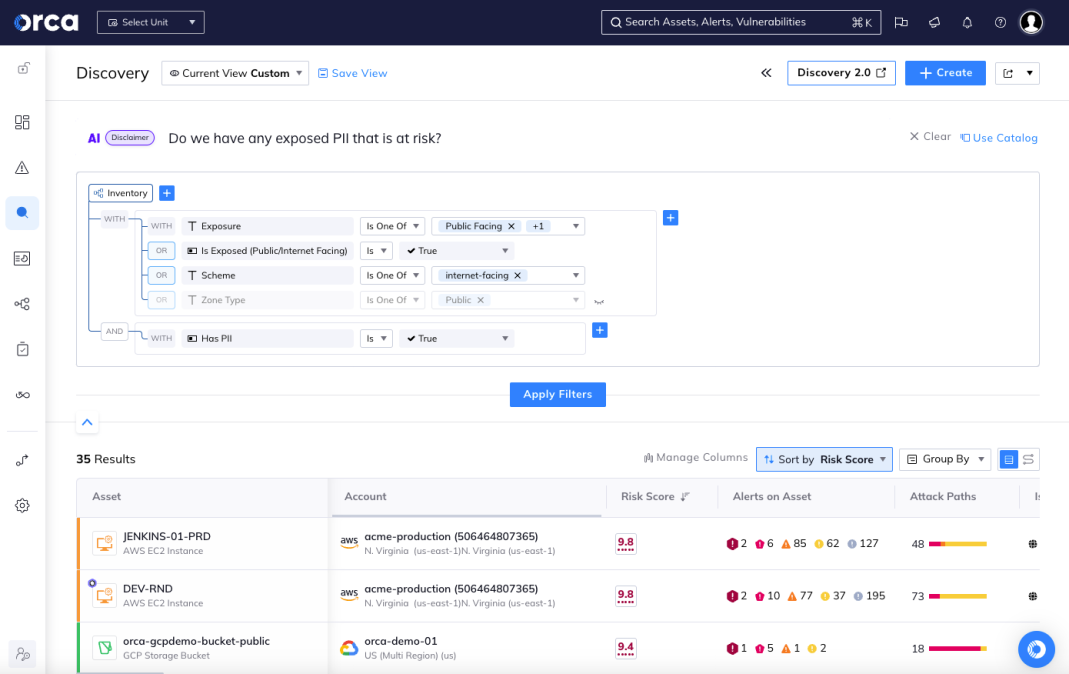
AI-powered search allows users to ask plain language questions
The Result? Improved Cloud Security
And the cherry on top is that by solving all these problems, organizations are also dramatically improving their cloud security postures and reducing the chance of becoming the victim of a data breach. In fact, the 2023 IBM Cost of a Data Breach Report found that organizations with extensive use of security AI and automation had a 39.3% lower average data breach cost compared to those with no AI or automation use.
“Organizations with extensive use of security AI and automation demonstrated the highest cost savings comparatively, with an average cost of a data breach at USD 3.60 million, which was USD 1.76 million less and a 39.3% difference compared to no use.”
2023 IBM Cost of a Data Breach Report
How Orca Leverages Generative AI
The Orca Platform widely leverages AI to enhance detection of risks, simplify investigations, and speed up remediation – saving cloud security, DevOps, and development teams time and effort, while significantly improving security outcomes. The Orca Platform AI integrations include:
- AI-generated, ready-to-use remediation steps
- AI-powered search as intuitive as asking a question
- IAM policy management powered by AI
- AI-generated alert and asset descriptions
- Intelligent anomaly detection using AI
Using a wide array of different AI integrations with Azure OpenAI, Amazon Bedrock, and Google Vertex AI, Orca is bringing customers the full benefits of AI, with more AI enhancements in the works.
“From the beginning, Orca has been dedicated to helping security teams scale to support cloud-native development with a platform simplifying cloud security. They have also been a frontrunner in leveraging generative AI to optimize efficiency to augment and accelerate their capabilities to secure rapidly scaling cloud environments as they become increasingly complex.”
Melinda Marks, Cybersecurity Practice Director at Enterprise Strategy Group
About the Orca Cloud Security Platform
The Orca Platform identifies, prioritizes, and remediates risks and compliance issues across cloud estates spanning AWS, Azure, Google Cloud, Oracle Cloud, Alibaba Cloud, and Kubernetes. Leveraging its patented SideScanning technology, Orca offers a single, comprehensive cloud security platform, detecting vulnerabilities, misconfigurations, lateral movement, API risks, sensitive data at risk, anomalous events and behaviors, overly permissive identities, and more.
Learn More
Would you like to learn more about Orca’s AI-driven capabilities? Schedule a personalized 1:1 demo and we can show you how your organization can take cloud security to the next level.
